If you’ve been working with Google Ads/AdWords for a while, you know that it’s great for targeting intent.
By serving ads against keyword searches, you can promote your product or service to someone exactly when they’re looking for it.
But “the almighty keyword” is losing its potency.
Not because keyword targeting isn’t effective, but because Google Ads is pivoting away from contextual and keyword targeting in favor of audiences.
As we lose control of precision matching, we have two (seemingly) less-desirable options: Get better at audience-first targeting, or lose market share to those who do.
But, done right, Google Ads audience targeting is a great way to reach – and generate demand among – your target market.
So, let’s look at what’s changing and how to win in the new “audience first” landscape – even if you’d prefer to stick with keywords.
The Upside Of Audience-First For Alphabet
Whether or not a keyword-less approach is in your company’s best interest, it’s certainly working well for Google’s parent company Alphabet.
This chart shows reported annual revenue (in billions), with an overlay of the release of non-keyword products.
-
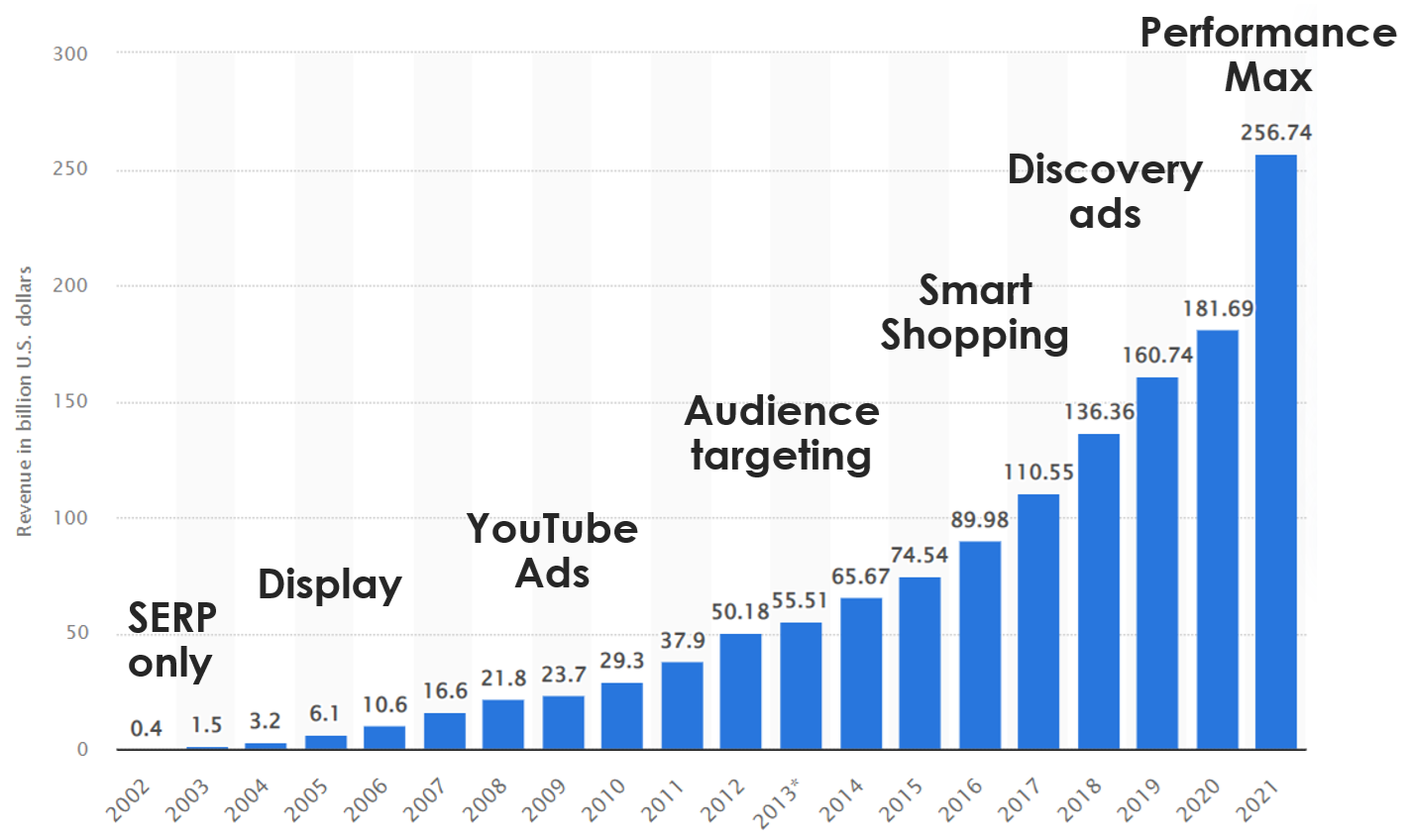 Screenshot from Statista, April 2021. Overlayed product names added by author.
Screenshot from Statista, April 2021. Overlayed product names added by author.
Google’s success is obviously due to more than just keyword-less ad offerings. But the expansion of its inventory is non-trivial.
Our prospects spend far less time Googling a product than they do not Googling a product.
If Google can reach them when they’re online but not on the SERP for a specific query, the opportunity for a paid click becomes almost limitless.
Your audience at any given time:
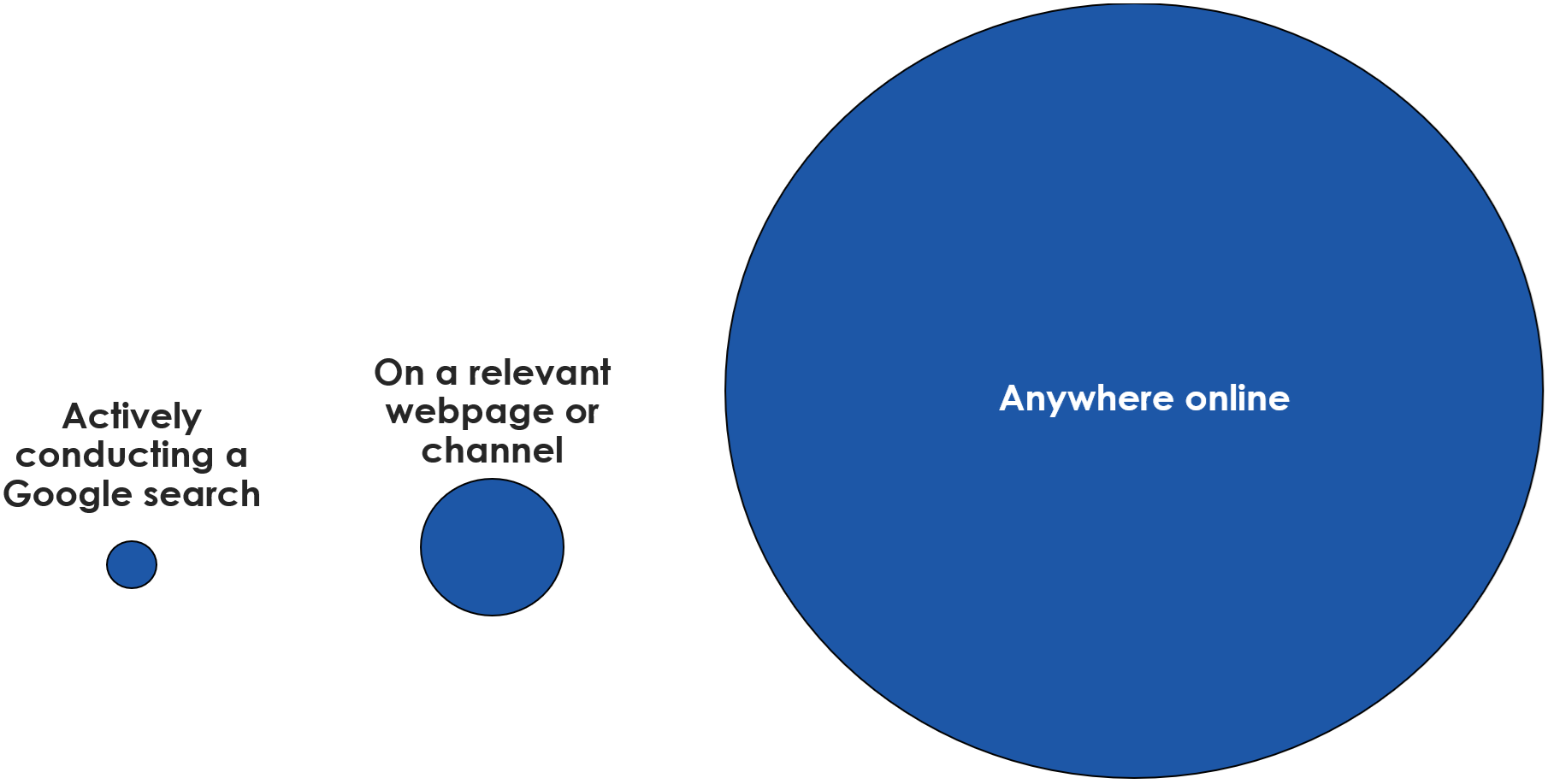 Screenshot by author, July 2022
Screenshot by author, July 2022
This expansion is great for Google’s bottom line, but how about yours?
Here’s a step-by-step look at how to build an audience-first strategy that keeps you competitive.
Create An Audience-First Strategy
An audience-first strategy isn’t entirely different from an intent-first strategy, but you’ll need to reframe how you target your prospects.
Define Your Campaign Objectives
The campaign’s goal reveals the best approach to take with strategy and targeting. Consider this frequently-asked audience question:
“Should I exclude remarketing from the audiences in my campaign?”
If the purpose of your campaign is to reach new audiences, then it would make sense to exclude prior visitors or customers.
If, however, the objective is to reach people who are familiar with your brand, then this exclusion would be fatal for that campaign.
Knowing your objective will make successful audience selection much easier to think through.
Define Your Audience And Segments
No, we’re not going to imagine a specific user avatar, what color shirt they’re wearing, and what they ate for breakfast this morning.
Instead, consider the attributes that make your audience unique in how they shop for, value, or use your product or service.
Consider things like:
- Who they are.
- Why they’re that way.
- How they’re solving their problem today.
You generally won’t find these answers in your Google Ads data.
It requires work outside of the platform (such as surveys or interviews) to research the characteristics of your customers.
Let’s say you’re selling plant-based (vegan) burgers.
Your audience might include multiple segments:
- Beef-lovers who need to reduce their red meat consumption or want to try something new.
- Devout vegetarians who want an alternative to dry black bean patties.
Those two groups have different desires, motivations, and alternative options.
They’ll respond best to different messages, and possibly different landing pages and offers.
We’ll need a segmented message strategy for the best results.
Build Your Audiences And Segments In Google Ads
Once you know who you’re trying to reach, you need a plan to reach them.
To reach vegetarians who might enjoy our plant-based burgers, we could target:
- Affinity > Food & Dining > Vegetarians & Vegans
- Custom segment > Interested/purchase intent > Vegetarian recipes and products
- Custom segment > Similar websites > DTC vegetarian sites (Boca, Morningstar Farm, Quorn)
- Custom segment > Similar websites > Vegetarian publications (Vegetarian Times, VRG, Vegout Mag)
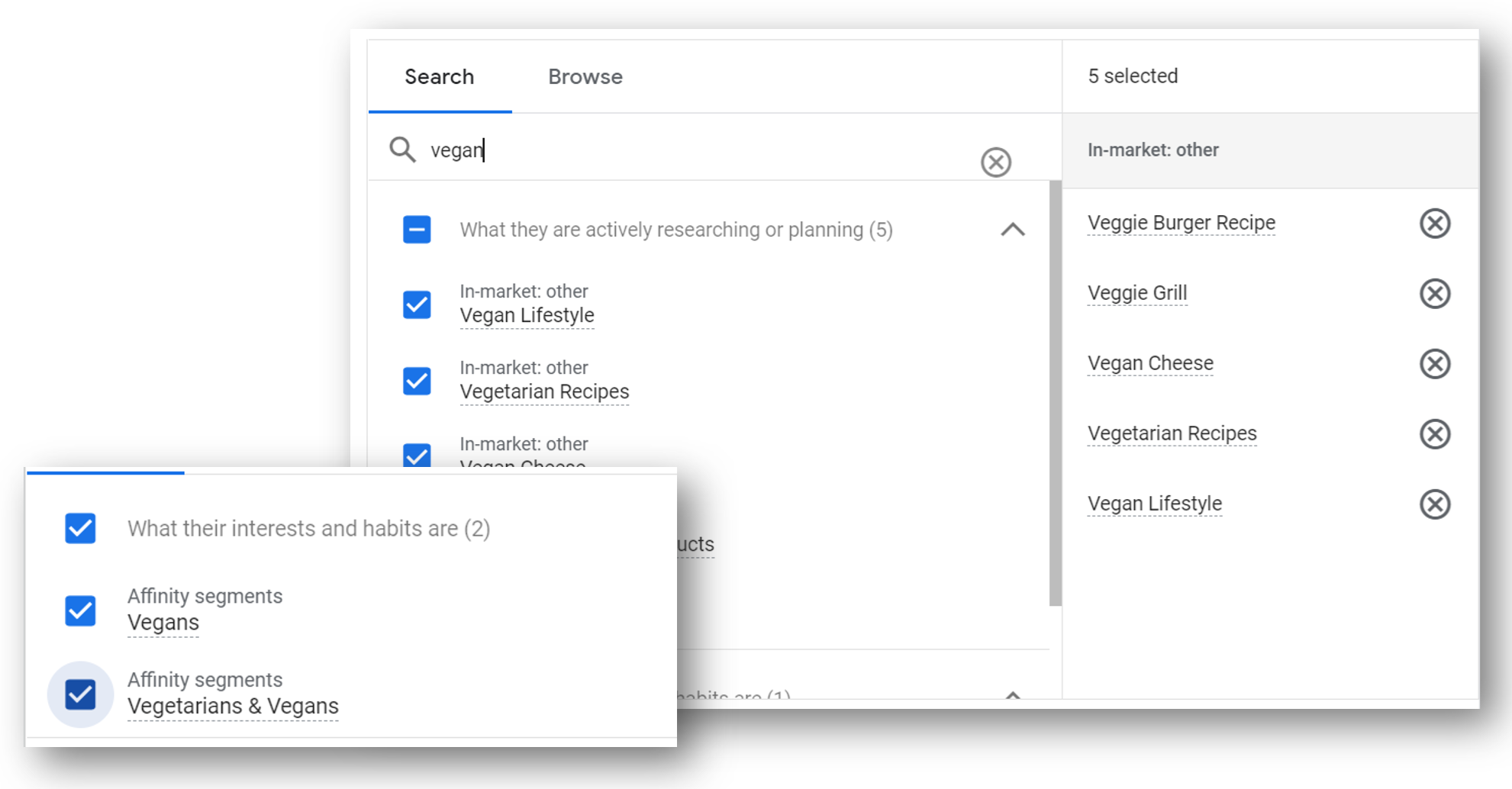

- Screenshot from Google Ads, April 2022
The audience segment types available in a specific campaign will depend on the campaign type or network you use.
For example, you can target Life events (such as marriage, graduation, or moves) on Display, but not Search.
You can create new segments from Audience manager or directly in your campaign or ad group from the Audiences tab.
Some campaign types now have you select an audience before adding ads or other marketing assets.
Create Distinct, Specific Ad Groups And Campaigns
As with keywords, there’s no sense in building out curated, thematic audience segments just to stuff everything back into a single ad group with generic ads.
Our “beef lovers” segment needs its own ad group and ads, separate from our “veggie” segment.
An exception to this rule is Search campaigns, where intent is strong, and audience segments can be layered into keyword targeting without separating them completely:
-
 Screenshot from Google Ads, June 2019
Screenshot from Google Ads, June 2019
But for non-Search campaigns, your audience segments are filling-in for keyword intent, so you’ll want to keep distinct segments separate.
Create Ads Targeted For Your Segments
You can customize your ads for each market segment with an audience-first strategy.
- Our ads for vegetarian audiences can promote benefits like cruelty-free flavor while emphasizing that these burgers are, in fact, vegan.
- Our ads for beef lovers can feature health benefits without sacrificing taste.
Test different messaging and treatments of your ads to see which perform the best for your segments.
Track And Optimize Your Segments
You can stack multiple, similar segments within an ad group.
If the same person matches more than one segment, Google Ads uses this hierarchy for which audience type gets the credit:
-
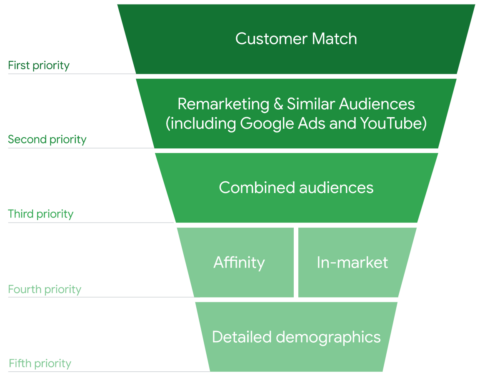 Screenshot from Google Ads support page, July 2022
Screenshot from Google Ads support page, July 2022
You’ll also find a lot of audience segment data in Audience Manager.
From Tools & Settings > Audience manager, just click the name of your data segment to see details like:
- Segment members.
- Match rate.
- Network eligibility (including segment size).
- Segment distribution.
- Segment use.
-
 Screenshot from Google Ads Audience manager, April 2022
Screenshot from Google Ads Audience manager, April 2022
Evaluate your audience performance and edit your settings to optimize and improve your campaigns.
“Don’ts” Of Audience-First Targeting
- Don’t target arbitrary attributes. Build audience segments and targeting around meaningful attributes, not arbitrary observations. Categories like age and gender are easy to track, but typically won’t define your market.
- Don’t use conflicting settings. If your objective is to run remarketing ads, don’t also select “optimized targeting,” which will reach people who haven’t engaged with your site.
- Don’t “set it and forget it.” Just like keyword optimization, audience optimization is an iterative process. Pay close attention to overly-broad terms in your custom segments.
“Do’s” Of Audience-First Targeting
-
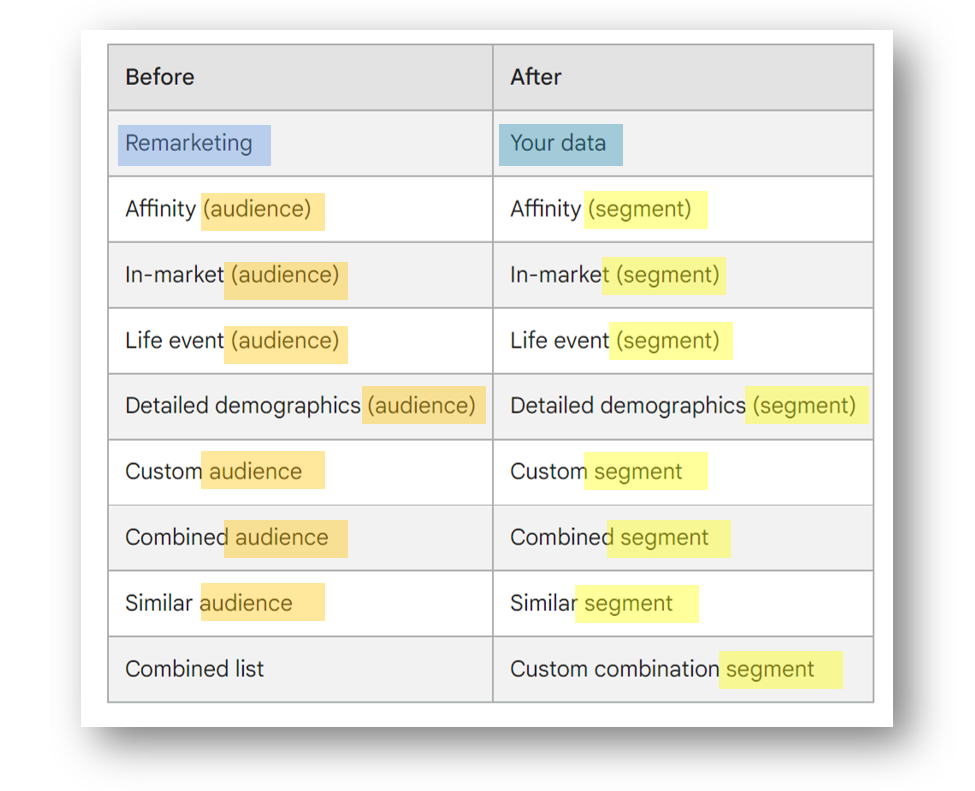 Screenshot from Google Ads support page, highlights by the author, July 2022
Screenshot from Google Ads support page, highlights by the author, July 2022
- Do expect a learning curve. Google Ads has been evolving its functionality and terminology over the last several years, making it feel new and unfamiliar. Be patient with yourself as you (re)learn the ropes.
- Do know the rules. Your industry, government restrictions, and other requirements will impact whether and how you can market. Review Google Ads support documentation and updates regularly, so you can stay in the loop.
- Do understand VUCA. VUCA is an acronym that stands for Volatility, Uncertainty, Complexity, and Ambiguity. No matter how tight the targeting you set up, you won’t achieve 100% accuracy. You can see how your own ads are personalized here. Expect some messiness.
-
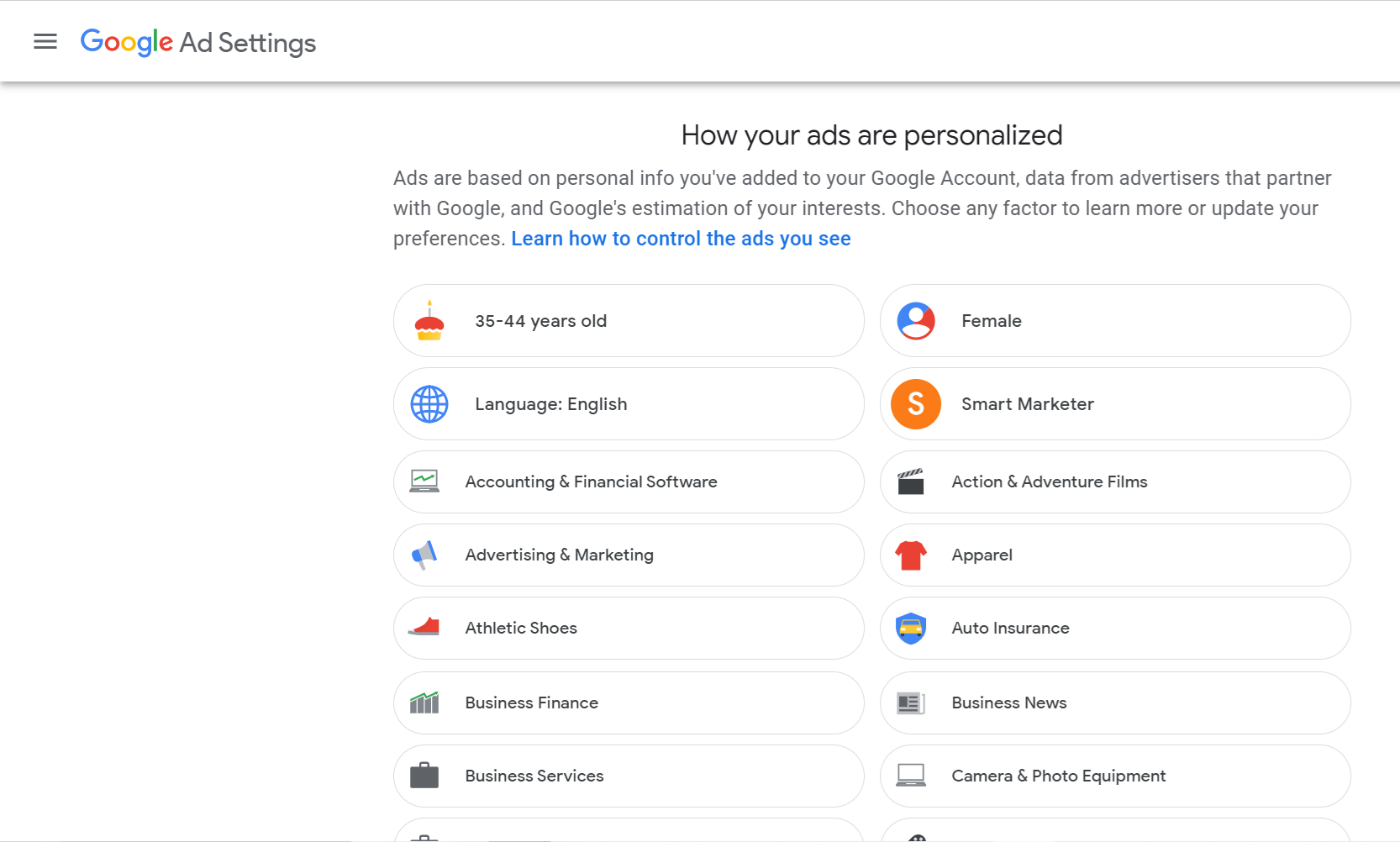 Screenshot of Google Ads Settings, April 2022
Screenshot of Google Ads Settings, April 2022
Conclusion
An audience-first strategy for Google Ads will help you prospect and reach your target market.
Knowing how to group and speak to individual market segments will improve your performance and increase your chances of success.
More resources:
Featured Image: Alones/Shutterstock
